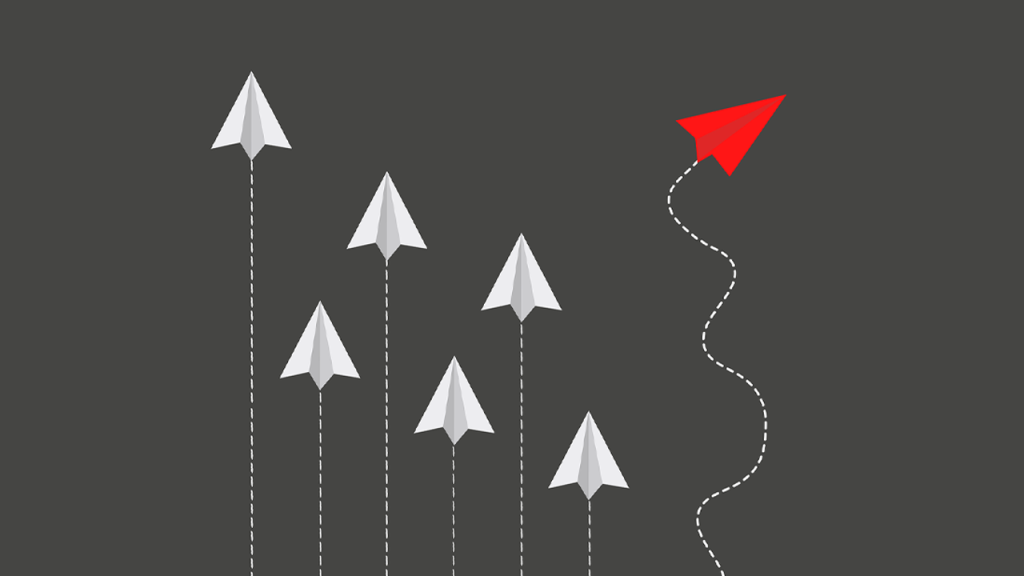UPDATED OCTOBER 24, 2023
Most businesses have competitors
Unless your business is a complete one-of-a-kind, you’ll be in competition with rival businesses.
And even if your business does something unique, it won’t be long before competing businesses start entering your market.
So how can you make your business different from all those others?
Well, you could just aim to be better than your competitors, but that might not sustain you for long.
Why it’s a bad idea to just be better than your rivals

The above image is a good visual demonstration of a brand that’s just better than its rivals.
In the image, the brand with the red arrow is leading — for now. But all the arrows are heading in exactly the same direction and there isn’t much distance between them.
That’s the risk of just being better than your rivals.
When what you have isn’t unique, it’s easily copied. And you’ll only be the frontrunner until a new frontrunner comes along.
Different is always better than better

See how the red paper plane in the image above is taking a different path and going off on its own tangent? That’s the value of being different.
Being different is harder to copy — and there are other benefits, too.
For example:
- Your brand could command a more premium price
- You won’t be in head-to-head competition with those other brands
- It will easier to create a distinct brand identity
- Your brand should be more memorable and recognisable
- It will be easier to build a loyal following of fans.
The best way to differentiate your brand from all those others is to look at your brand positioning.
What is brand positioning?
Brand positioning refers to where your brand sits in the market, in relation to your competitors.
It’s also a marketing strategy that highlights your brand’s uniqueness to help you stand out from those competitors.
To position your brand for success, you need to know:
- Who your ideal customers are
- Who your competitors are
- How your brand is different
- The unique value, benefits and attributes you’re bringing to the table.
When you know this, you can work on becoming known as the go-to brand for that particular thing.
Who are your ideal customers?
Your ideal customers are the customers that are the ideal match for what you’re offering.

How your ideal customers are the best match
Fit the demographics
In terms of their demographics, for example, they:
- Are a suitable age for your product/service
- Are the appropriate gender, where relevant
- Have sufficient income to buy from you
- Are suitably educated/qualified
- Have the right occupation
- Are based in the right location.
Have the right motivation
Your ideal customers might be motivated to buy from you because they have:
- A problem they need to solve in a certain way
- A specific goal they want to achieve
- A particular lifestyle or aspiration they want to fulfil
- A specific desire or need.
Align with your brand
Your ideal customers are those who are closely aligned with your brand and what you stand for.
They might be drawn to you because you’ve demonstrated your competence, because they like the quality of your products or because they share your values and appreciate what you stand for.
Appreciate your value
Your ideal customers appreciate the value of what you’re offering and are willing to pay for it.
Respond to marketing
These customers respond well to your marketing. They take advantage of offers, explore your new ranges and are often early adopters of new products and services you introduce.
Show loyalty
They’re most likely to become loyal customers, giving you repeat business and the opportunity to sell, upsell and cross-sell your products and services.
They’re also likely to become brand ambassadors, regularly engaging with your socials and recommending you to others they know.
Who are your competitors?
As I said at the beginning of the article, brand positioning is where your brand sits in relation to its competitors.
You might have some idea of which other businesses you’re competing with, but how do you find all the ones you should be aware of?

The four kinds of competitors
There are four main kinds of competitor you should be aware of: local competitors, direct competitors, indirect competitors and alternative competitors.
1. Local competitors
If you operate in your local area, you’ll have local competitors that share the same geographical location.
People like to work with local businesses for all kinds of reasons. For example, it might be because it’s more convenient or because they’re more community minded.
2. Direct competitors
Direct competitors are the ones offering the same kind of products/services to yours.
For example, if you’re a local florist selling fresh flower bouquets, your direct competitors would include other local florists and national florists. That’s because these competitors supply the same or very similar products.
The local florist has the advantage of being able to serve walk-in customers.
3. Indirect competitors
Indirect competitors are the ones that offer something similar to you, but they don’t specialise in it and it isn’t their main source of business.
For the local florist, this would be other suppliers of fresh flower bouquets, like garden centres; online retailers, like Moonpig; supermarkets; and petrol stations.
4. Alternatives
Alternatives are just that — brands that are offering an alternative to what you’re offering.
To work out who these brands might be, imagine that what you’re offering doesn’t exist. What would your prospects do then and how would they solve their problem?
Let’s look at the local florist again and alternatives to fresh flower bouquets. In this case, alternative competitors might be sellers of potted flowering plants, silk flower arrangements or flower seeds.
What are your brand differentiators?
What makes your brand different to your competitors?
There are a number of things you can look at here, so let’s go through some of them.

What makes your brand different?
Your brand’s target market
Maybe your differentiator is who you work with.
By niching down and offering your services to a very specific market, you could hit on something nobody else is doing and make it your own.
Is there a specific target market you specialise in working with/selling to that no other brand does?
It could be an industry you’re familiar with from your previous employment. Or a market you’ve come to know well and enjoy working with.
For example, maybe your brand is:
- Tough activewear for toddlers
- A beauty salon for the over-50s
- A coach for ambitious women in business
- A marketing agency for agricultural products
- A health and safety consultant for the food industry.
Your brand’s relevance to the market
Maybe your brand is more relevant to the wants, needs and pain points of your target market because you work hard to understand your market better than any other brand.
For example, maybe:
- You’re the ‘original and best’ in your sector
- Your brand story is especially relevant and relatable
- You post relevant content that addresses the needs of your market
- You’re constantly innovating and launching new products/services that match your market’s needs.
Your brand’s customer service
Maybe you want to be renowned for giving the best customer service in your sector.
For example, maybe you:
- Have a generous trial period or introductory offer
- Use real people rather than chatbots and automated systems
- Promise to resolve complaints or queries within a set amount of time
- Have a no-quibble returns policy
- Offer a longer guarantee on your goods, services or repairs.
The problem you solve
Maybe the problem you solve for your customers is a tough one. It might be something you’ve had success with, but where your competitors have failed.
For example, if you:
- Have specialist knowledge or experience in a particular sector
- Can introduce businesses to markets or agencies that are notoriously difficult to access
- Have a product that does something extra, or special, that your competitors’ doesn’t
- Offer a product or service that’s customisable in ways your competitors’ aren’t.
The price point you sell at
Maybe you’re the cheapest brand in your sector.
For example, you might provide a basic, no-frills service that’s perfectly adequate for most of your market. Or you might offer the cheapest products with a lowest-price-guarantee.
You could also be the most expensive brand in your sector, but you’d probably need to justify your high prices with an additional differentiator.
Your credibility
You might have more credibility in your field than your competitors.
This might be because of your:
- Background
- Transferrable skills
- Specialist knowledge/expertise
- Personal experience/understanding
- Awards/achievements/credentials.
Your brand’s expertise
Maybe your differentiator is your brand expertise.
For example, that might be due to you:
- Having longevity and resilience in your market
- Being able to solve most problems, however complex
- Giving the best impartial advice and recommendations
- Employing only the very best experts for your brand
- Being the ‘original and best’ in your sector.
Your brand story
People love a good story — and every brand story is unique.
Your story is a good place to show some personality and make a connection with your audience.
For example, you might tell them:
- Who you are and what your background is
- How and why you started your business
- Where your company name/identity came from
- What your goal or mission is
- What problems you faced and how you resolved them
- How the business evolved and became what it is today.
Your look and style
If you work in an industry where every brand looks very similar, presenting yourself differently can be a risk.
But if it’s done well, and with some thought, it can make you stand out. And, out of all those others, it can make your brand the one people remember.
The way you communicate
This covers everything from the clarity and ease of your communications to the tone of voice you use.
Businesses that communicate clearly and provide information that’s easy to read are more likely to get their communications read than ones that don’t.
Tone of voice is the difference between lit, amazing and jolly good. It can make your business sound like a huge multinational or Bob from down the road. Like a plain-speaking mechanic or a fabulous fashionista.
Good communication is absorbing and addictive — people love to read it, watch it and listen to it. If they like what you do, they’ll keep coming back for more.
The convenience you offer your customers
Maybe your brand could be known for offering the easiest and most convenient service in your sector.
That might include:
- A super-easy-to-use website interface and service
- Personalisation that learns from previous purchases
- Easy one-click ordering
- A 24/7 service
- Same-day delivery
- Listening to your customers to find out what would be most convenient for them and implementing it.
The quality of your products or services
Maybe you put more into the quality of your products/services than your competitors.
For example, maybe you:
- Source the best and most durable premium-quality materials
- Work with the finest fresh/organic/luxury ingredients
- Specialise in the best quality craftsmanship
- Incorporate the most secure, reliable and sophisticated technology
- Put your products/work through the most stringent quality checks.
What you stand for and care about
People like to deal with ethical companies that share their values.
Some customers will actively boycott companies that are known for poor ethical practices, like not paying their taxes, being environmentally negligent or putting profits before people.
If your ethics are worthy of your target customers’ support, you can and should promote them.
For example you might be making a stand for:
- Green issues and sustainability
- Using fair trade products
- Fairness and equality
- Integrity and decency
- Education and opportunities for young people
- Employee wellbeing and mental health awareness.
Your brand’s promise to its customers
Maybe your brand makes a promise that none of your rivals do.
For example, that could be the promise of a:
- Specific result or outcome
- Consistent and reliable service
- Delivery of the product/service within a specified time
- Money-back satisfaction guarantee
- 10-year guarantee/warranty.
Why you do what you do
Your why is your brand’s purpose and reason for being. It should be at the heart of everything you do.
Proof you’re as good as you say
Proof of your claims can be a powerful differentiator for your brand.
For example, if your brand is:
- The most recommended in your sector, with the most positive reviews
- Chosen by more customers than any other brand or local brand
- Trusted by big brand names you’ve supplied/worked with
- Selling something that’s quantifiably proven in testing, e.g.:
- 8 out of 10 cats prefer it
- It’s 10 times more effective than other brands
- It lasts 10 times longer than other brands e.g. batteries
- It does 10 times more than other brands e.g. washing-up liquid.
Your USP and value proposition
When you understand your ideal customers, competitors and brand differentiators, you can hone in on your Unique Selling Proposition (USP) and value proposition.
Your Unique Selling Proposition (USP)
Your USP should set you apart from your competitors by highlighting one key selling point that’s unique to your brand and differentiates you from your competitors.
It’s communicated in the form of a short statement that describes a unique feature or benefit of what you’re offering.
For example:
- 1000 songs in your pocket (Apple iPod)
- 30-minute pizza delivery or it’s free (Domino’s)
- Empowering the world to design (Canva).
Your value proposition
Your value proposition is a broader statement that communicates the overall value your customers can expect to get from your product or service.
It should include:
- A description of what you offer
- Your target audience
- The problem you’re solving
- The main benefits
- Why you’re different.
For example:
- Safe drivers are guaranteed to save money with our fully comprehensive over-50s motor insurance
- Our eco-friendly, biodegradable washing pods are tough on stains but kind to the environment
- Our stylish blackout curtains create the perfect conditions for sleep at any time of day.
What’s next?
By now you should have a good idea of how your brand is different, how you want it to be perceived by your target audience and how you want to position it in your market.
Communicating your differences
The next step is to communicate your differences to your target audience and show them why you’re the right brand for them.
And that’s where I come in.
I’m Jenny Lucas, a freelance copywriter and content writer based in Leicester, UK.
I specialise in writing web copy and blog content that helps brands like yours to celebrate your differences and stand out in your market.
To find out more about me and what I could do for you, visit my main website.
To discuss a project, please get in touch.

You might also like…



